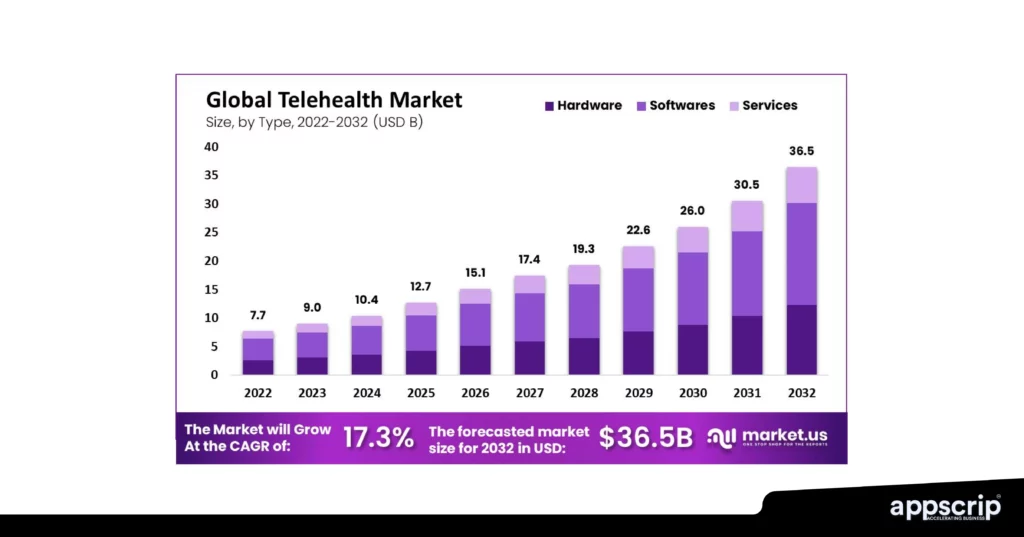Telehealth has quietly become one of the most relied-upon parts of healthcare in 2025. It’s no longer an emerging option, but how a growing majority of people connect with doctors and specialists. According to a 2024 report from the American Hospital Association, over 70% of U.S. healthcare providers now offer some form of virtual care.
What started as a temporary fix during the pandemic has evolved into a permanent shift in how care is delivered. From virtual mental health to remote chronic care management, best telehealth platforms are transforming patient engagement, accessibility, and cost-efficiency.
This article is a hands-on guide for anyone looking to build or invest in the telehealth space.
TL;DR
- Telehealth is booming in 2025, with over 70% of U.S. healthcare providers now offering virtual care solutions.
- A telehealth platform is a digital system enabling remote consultations, diagnosis, prescriptions, and follow-ups.
- Key features of top platforms include HIPAA-compliant video calls, system integration, user-friendly interfaces, wearable support, and secure messaging.
- Leading platforms in 2025 include Teladoc, Amwell, MDLIVE, Doxy.me, Zocdoc, HealthTap, PlushCare, and eVisit, with each having its strengths and pricing models.
- Benefits of telehealth range from accessibility and cost savings to better patient engagement, lower no-show rates, and access to specialists.
- Choosing the right platform involves considering integration, compliance, scalability, and user experience, and Appscrip offers a robust, pre-built option for providers and startups.
Appscrip’s telehealth platform offers fast deployment and a full feature set including AI triage, EMR integration, video consults, pharmacy modules, and real-time communication tools.
What is a Telehealth Platform?
Think of a telehealth platform as a virtual clinic that fits right into your pocket. It’s a technology solution that allows patients and healthcare providers to interact remotely using video calls, messaging, apps, and secure data sharing.
Whether it’s a routine check-up, a mental health session, a chronic disease follow-up, or even emergency consultations, telehealth platforms bring healthcare services straight to people’s homes.
The concept started gaining attention in the early 2010s. But it wasn’t until around 2020, driven by the urgency of the pandemic, that telehealth truly exploded. Today, in 2025, it’s no longer an add-on to traditional healthcare but a central part of how care is delivered across primary care, mental health, dermatology, chronic condition management, and more.
Importance in Modern Healthcare
Telehealth has reshaped the idea of access to healthcare. For people living in remote areas, or for patients who face barriers like transportation, telehealth means that quality care is no longer out of reach. It’s closing the gap between patients and providers while reducing waiting times and minimizing the costs tied to traditional care models.
Beyond accessibility, telehealth platforms also help healthcare systems operate more efficiently. Hospitals and clinics can manage patient loads better, focus in-person visits on critical cases, and even extend specialist care across larger regions.
A 2024 survey by the National Center for Health Statistics showed that 63% of patients preferred telehealth for non-urgent consultations, highlighting how much expectations around convenience and speed have changed.
Now, let’s dive into what features define the best telehealth platforms in today’s market.

Key Features of the Best Telehealth Platforms
User-Friendly Interface
First impressions matter, especially when it comes to healthcare. Simple login processes, intuitive dashboards, and clear instructions ensure that even those who are not tech-savvy can schedule appointments, access medical records, and join video consultations without stress.
Security and Compliance
When it comes to healthcare, security isn’t negotiable. Leading telehealth platforms are built with strict compliance standards like HIPAA (Health Insurance Portability and Accountability Act) to protect sensitive patient information.
Features like end-to-end encryption, secure login authentication, and audit trails are now standard.
Integration with Existing Systems
Imagine the frustration if a telehealth platform couldn’t talk to your existing electronic health record (EHR) system. Thankfully, the best platforms ensure seamless integration with popular EHRs, billing software, and even pharmacy networks.
The goal is to create an uninterrupted flow of information, which means faster, more accurate patient care without juggling multiple systems.
Multi-Device Accessibility
In today’s world, patients expect healthcare access whether they’re on a smartphone, tablet, or desktop. Top telehealth platforms offer fully responsive designs and dedicated apps that work smoothly across devices. This ensures that care is never more than a few clicks away, no matter where the patient is.
Appointment Scheduling and Reminders
Modern telehealth solutions go beyond just video calls. They offer built-in scheduling tools that allow patients to book, reschedule, or cancel appointments easily. Automated reminders via SMS, email, or app notifications help reduce no-show rates and keep patients engaged.
Remote Monitoring and Wearable Integration
Some of the leading platforms now integrate with wearable devices like fitness trackers and smartwatches. This real-time health data like heart rate, oxygen levels, and activity metrics can be fed directly to providers, enabling better monitoring of chronic conditions without the need for frequent in-person visits.
Top 8 Telehealth Software Solutions in 2025
The telehealth world in 2025 is crowded, but a few platforms continue to lead the pack by doing things differently. Whether you’re a startup looking to build something new or a provider looking for inspiration, these are the names worth knowing:
- Teladoc Health: Teladoc offers just about everything in healthcare – urgent care, mental health, dermatology, and even chronic condition management. What makes them stand out is their use of AI to handle initial assessments, which speeds up how fast patients get matched to the right care. They’re used by hospitals, employers, and insurance companies, and they operate 24/7.
- Amwell: Amwell is the quiet workhorse of enterprise telehealth. It’s built for scale and works best when integrated directly into hospital systems. That means healthcare providers don’t have to reinvent their workflows, it all just plugs in. With HIPAA and HITRUST compliance baked in and options for multilingual support, it’s a favorite among large institutions and insurers.
- MDLIVE: MDLIVE makes speed and simplicity its biggest selling points. The app is smooth, the wait times are short, and they handle everything from urgent care to therapy and psychiatry. They’ve partnered with a lot of major insurers too, which makes pricing way more affordable for a broad audience.
- Doxy.me: If you’re just getting started or running a solo practice, Doxy.me is a lifesaver. It’s browser-based, which means no downloads or complicated sign-ins. Patients can join with a link, and doctors get the basics for free. For more features like screen sharing and waiting rooms, there’s a paid version, but even that’s budget-friendly.
- Zocdoc: Zocdoc started out helping patients book appointments, but now they’ve fully stepped into telehealth. It’s super patient-friendly and you can filter by specialty, check reviews, and jump on a virtual consult in minutes. It’s all about choice and control, making it a great option for users who want flexibility.
- HealthTap: HealthTap is like a hybrid between a telehealth platform and a health membership plan. You pay a monthly fee and get unlimited messaging with doctors, plus low-cost video visits. It also comes with an AI symptom checker to help patients figure out what kind of care they need before jumping into a consultation.
- PlushCare: If you’re looking for continuity and want to build a long-term relationship with your doctor, PlushCare fits the bill. You typically see the same doctor each visit, which is great for ongoing care. They handle everything like prescriptions, labs, referrals and work with many employer health plans.
- eVisit: eVisit offers tons of customization, integrates with EHRs, and supports complex workflows involving multiple providers. If your goal is to create a full-scale digital care system, this is the kind of platform you look at.
Comparison of Features and Pricing
Here’s a quick snapshot of how they stack up:
| Platform | Key Strengths | Pricing (approx.) |
| Teladoc Health | Broad service rangeAI-driven diagnostics | Memberships starting ~$75/year |
| Amwell | Seamless integration with health systemsScalable for enterprises | $79 per urgent care visit |
| MDLIVE | Fast schedulingWide insurance coverageUser-friendly app | $0 with some insurance or ~$82/visit |
| Doxy.me | No downloads neededFree basic planGreat for small practices | Free basic, paid premium options |
| Zocdoc | Real-time doctor availabilityEasy filtering and booking | Provider-determined costs |
| HealthTap | Unlimited text messagingAI symptom checker | $45/month membership |
| PlushCare | Continuity with same doctorFull-service virtual clinic | ~$14/month plus $99 per visit |
| eVisit | Custom workflowsBuilt for hospital-scale care | Custom pricing for institutions |
Benefits of Using Telehealth Platforms
Accessibility and Convenience
One of the biggest wins for telehealth is how easy it makes healthcare accessible. No more long drives, crowded waiting rooms, or wasting half a day for a 15-minute consult. Whether you’re a busy professional, a parent juggling multiple schedules, or someone in a rural area, telehealth brings healthcare right to your doorstep.
Cost-Effectiveness
Telehealth doesn’t just save time, it saves money too. Virtual visits are often significantly cheaper than in-person appointments. They also cut down on secondary costs like transportation, childcare, and missed work hours.
According to a FAIR Health report, the average telehealth visit cost about $50 in 2024, compared to $150 for an in-person doctor’s office visit. It’s no wonder telehealth is increasingly seen as a smart financial choice.
Enhanced Patient Engagement
Staying engaged with your healthcare is easier when it’s just a click away. Telehealth platforms allow patients to schedule follow-ups, track their treatment plans, and communicate with providers more frequently.
Data from the American Medical Association shows that patients who engage with their care online are 30% more likely to adhere to treatment plans. More touchpoints mean better outcomes, plain and simple.
Reduced No-Show Rates
Missed appointments are a headache for both providers and patients. Telehealth makes it easier for patients to show up virtually. With flexible scheduling, quick reminders, and no commute involved, more patients follow through with their care plans.
In fact, a 2024 study published in JAMA found that clinics using telehealth saw no-show rates drop by up to 35%.
Better Access to Specialists
Not every town has a cardiologist, dermatologist, or behavioral health expert but telehealth makes those specialists reachable. It helps patients in underserved areas get the care they might otherwise wait weeks or months for, often within a day or two.
Support for Continuity of Care
With telehealth, patients can stick with the same provider for regular follow-ups, check-ins, or long-term care. This consistency builds trust and leads to better diagnosis, more personalized treatment plans, and overall stronger patient-doctor relationships.
Next, we’ll guide you on how to pick the right telehealth platform tailored for your needs.
How to Choose the Best Telehealth Platforms for Your Needs
Considerations for Healthcare Providers
If you’re a healthcare provider, choosing the right telehealth platform can make or break your patient relationships. Here are a few key things to think about:
- Integration: Make sure the platform plays nicely with your existing EHR system. You don’t want to deal with messy data transfers or manual entry.
- Compliance: Double-check HIPAA compliance and security features. Patients trust you with sensitive information, and your platform needs to protect it.
- Scalability: Your needs today might not be your needs tomorrow. Pick a platform that can grow with your practice, like adding specialties, providers, or even multilingual support.
- Customization: Look for platforms that allow you to brand your telehealth experience. A consistent patient journey builds loyalty and trust.
- Developer Support: If you’re building a custom experience or launching a new telehealth venture, it helps to work with a platform that offers strong development support and pre-built modules. Solutions like Appscrip’s telehealth app platform are designed to offer scalability, compliance, and are ideal for clinics and healthcare startups ready to move quickly without compromising on quality.
Factors for Patients to Consider
As a patient, not all telehealth platforms are created equal. Here’s what to keep in mind:
- Ease of Use: Look for simple interfaces that don’t require a tech degree to figure out.
- Availability of Services: Some platforms specialize in urgent care, others in mental health or chronic care. Choose one that fits your specific needs.
- Insurance Coverage: Check if the platform accepts your insurance or offers affordable out-of-pocket pricing.
- Doctor Access: Make sure there are qualified, board-certified doctors available when you need them, especially if you’re looking for 24/7 access.
As care continues to shift toward digital-first models, the demand for reliable, flexible, and scalable telehealth platforms has never been higher.
For entrepreneurs, startups, and healthcare providers looking to build or upgrade their virtual care offerings, the question isn’t if you should launch, rather it’s how fast you can get to market.
That’s where Appscrip makes a difference.
Our telehealth platform has one goal: to help you launch smarter and scale faster. Whether you’re entering mental health, primary care, specialty consults, or full-scale hospital networks, our platform can be tailored to your needs. Here’s what’s included:
- Video consultations with crystal-clear quality
- Smart appointment scheduling and calendar integrations
- AI-based triage tools to route patients quickly and accurately
- Seamless integration with EMRs and patient health records
- Secure messaging and real-time provider communication
- Multi-language, multi-currency support for global use
- Built-in pharmacy and prescription ordering
And the best part? It’s all pre-built and customizable, so you can move from idea to launch in weeks, not months.
If you’re ready to bring your telehealth vision to life with a proven platform that supports your business goals, we’re here to help.
Build with Appscrip’s Telehealth Platform, and let’s create the future of healthcare together.





